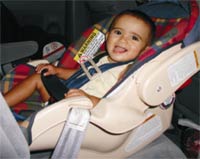|
 Child Passenger Safety Child Passenger Safety
National Child Passenger Safety Week,
February 8–14, 2004
Motor vehicle crashes are the leading cause of death among children in the United States. In 2002, 1,543 U.S. children ages 14 years and younger died as occupants in motor vehicle crashes and approximately 227,000 were injured. That’s an average of 4 deaths and more than 622 injuries each day.
Of children ages 14 years and younger who were fatally injured in 2002, 50% were completely unrestrained (NHTSA 2003).
Most of these injuries could have been prevented. Placing children in age-appropriate restraint systems reduces serious and fatal injuries by more than half (NHTSA 2003).
National Child Passenger Safety Week occurs each year during the week of Valentine’s Day, bringing public attention to the importance of safely transporting children. This year, the focus of National Child Passenger Safety Week is on
booster seats.
 Facts Facts
Available from
CDC's child passenger safety
fact sheet. A
fact
sheet for the media also is available
Back
to Top
Highlighted Topics
Impaired
Driving and Child Passengers
-
Drunk
and Drugged Driving Prevention Month
-
A CDC study showed that more than two-thirds of children ages 14
years and younger killed in alcohol-related crashes were riding
with the drinking driver (Shults 2004).
Shults RA. Child passenger deaths involving drinking
drivers—United States, 1997–2002. MMWR 2004;53(4):77–9. (Note:
Erratum published 2004;53(5):109)
-
CDC
and the Task Force on Community Preventive Services conducted systematic
reviews on alcohol-impaired driving
interventions and recommended
five different types of interventions.
Using
Booster Seats
Children should start using a booster seat when they grow out of their child safety seats (usually when they weigh about 40 pounds). They should continue to ride in a booster seat until the lap/shoulder belts in the car fit properly, typically when they are 4’9” tall (CDC 1999).
- What is a booster seat?
Belt-positioning booster seats raise children up so the lap and shoulder belts fit correctly. They require a lap and shoulder belt combination. Shield booster seats, which have a plastic shield in front of the child, offer less protection and should not be used.
- Why use a booster seat?
Booster seats have been shown to decrease injuries for children ages 4 to 8 when compared with seat belt use alone. During 2000, 376 children ages 4 to 8 years died in motor vehicle crashes in the United States. Of these, 46% were unrestrained and 36% were restrained in a car seat belt, without a booster seat (NHTSA 2001).
- For more information
Check out the following web sites to learn more about child passenger safety and size-appropriate restraint recommendations:
Kids
in the Back for a Safer Ride
All children
ages 12 years and younger should ride in the back seat, the
safest part of a vehicle in the event of a crash.
This is especially important for vehicles with front
passenger-side airbags.
Riding in the back seat is associated with at least a 30%
reduction in the risk of fatal injury in cars without
front passenger side airbags.
Placing children in the back seat of vehicles with front
passenger side airbags reduces this risk by 46%.
Infants in rear-facing child safety seats should never be
placed in a seat in front of an airbag.
About
one-third of children ages 12 years and younger who were killed in 2000
were riding in the front seat.
Airbags
and Children
Even
in a slow-speed crash, the force of a deployed airbag can injure or
kill a young child. Riding in the back eliminates children’s risk of injury from
front passenger-side airbags. Children ages 12 years and younger
should always ride in the
back seat, the safest part of the vehicle in the event of a
crash.
Below are two CDC publications about airbags and children:
Effective Interventions
to Increase Child Safety Seat Use
Available
from CDC's Motor
Vehicle Occupant Safety page.
Back
to Top
|
